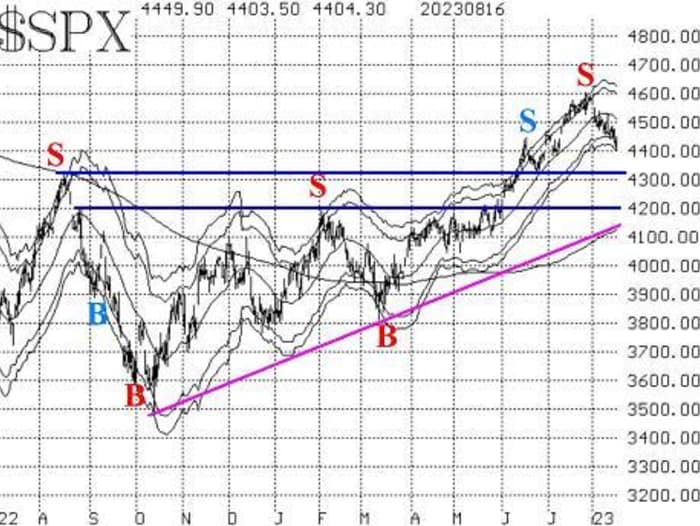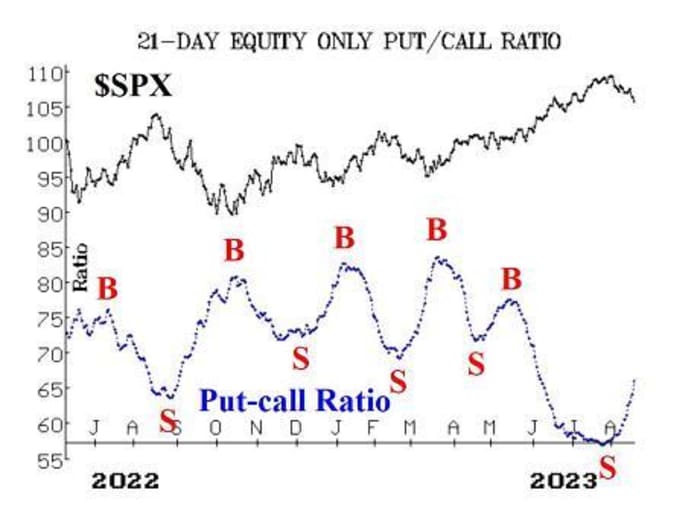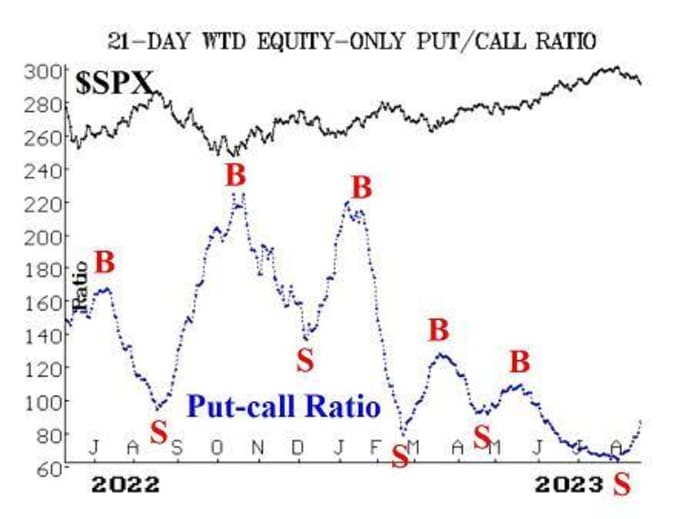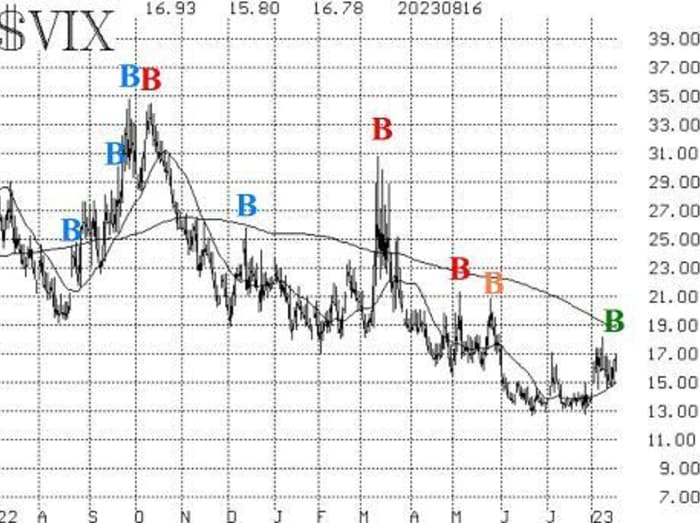“ The chart of the S&P 500 is bullish as long as the index closes above 4330. ”
The stock market, as measured by the S&P 500 Index SPX, has continued to remain in the downtrend that started near the 4600 level in late July. The decline has now reached the 4400 level, and that is good news in that it fills a number of gaps on the SPX chart — gaps which were created in late June and early July.
There is potential support near 4400. But the major support levels are at 4330 and 4200, both of which are marked by blue horizontal lines on the accompanying chart of SPX. A failure of the support at 4330 would be an extremely negative development. Such a failure would completely erase the breakout that took place in June.

The decline has also touched the -4? “modified Bollinger Band” (also visible on the SPX chart), and that is enough to fulfill the target of the McMillan Volatility Band (MVB) sell signal that was generated in late July.
Meanwhile, the equity-only put-call ratios are exploding to the upside, and that is bearish. As long as these ratios are rising, they will remain on sell signals. Those sell signals will remain in place until the ratios roll over and begin to trend downward.


Breadth has been negative and it’s getting worse. Therefore, the breadth oscillators are still on sell signals, but they have reached a deeply oversold condition. Eventually, those oversold conditions will produce buy signals, but not until breadth stabilizes and begins to improve. “Oversold does not mean buy.” So, for now, this indicator remains negative.
New Lows on the NYSE have finally gained some strength, and they have outnumbered New Highs for the last three trading days. That stops out the long-term buy signal that originated last March, and which was one of the most successful buy signals on record for this indicator. This new development is not a sell signal, though. For a sell signal to occur, New Lows on the NYSE would have to 1) be greater than 100 issues for two consecutive days, and 2) be greater than New Highs on those two days.
VIX VX00, +0.79% has edged a bit higher with the selling in stocks, but not by much. In fact, VIX briefly spiked up last week, and then retreated again. That was enough to generate a VIX “spike peak” buy signal; that buy signal would be stopped out by a VIX close above 18.14 (last week’s high). Also, the trend of VIX buy signal remains in place as long as the 20-day Moving Average of VIX is below the 200-day MA. Those two are beginning to converge but are still four points apart, so they are not really close enough for a crossover of the 20-day above the 200-day to be likely.

The construct of volatility derivatives remains positive as well since the term structures of the VIX futures and of the CBOE Volatility Indices continue to slope upwards. There would only be concern if the term structure inverted, at least in the front end. August VIX futures expired this week, so the front month is now September. Thus, we will be watching the price of September VIX futures vis-à-vis the price of October futures. If September rises above October, that is normally a dire warning sign for stocks.
In summary, as negative as some of the indicators are, the chart of SPX is bullish as long as the index closes above 4330. Thus, we are maintaining a “core” bullish position (albeit one with a small delta). We have added other confirmed signals around that “core” position.
New Recommendation: U. S. Steel (X)
A pair of competing $ 35 takeover bids have emerged for U. S. Steel X, +0.20%. Option volume has been exceptional, and stock volume patterns are positive as well.
Buy 3 X Sept (15th) 31 calls at a price of 1.70 or less.
X: 31.15 Sept (15th) 31 call: 1.67 bid, offered at 1.73
New Recommendation: Phillips 66 (PSX)
Option volume in PSX, +1.22% has risen sharply on vague chatter that the company was an activist investor (Elliott Management) target.
Buy 2 PSX Sept (15th) 115 calls in line with market.
PSX: 114.91 Sept (15th) 115 calls: 3.60 bid, offered at 3.80
Follow-up action:
All stops are mental closing stops unless otherwise noted.
We are using a “standard” rolling procedure for our SPY spreads: in any vertical bull or bear spread, if the underlying hits the short strike, then roll the entire spread. That would be roll up in the case of a call bull spread, or roll down in the case of a bear put spread. Stay in the same expiration and keep the distance between the strikes the same unless otherwise instructed.
Long 800 KOPN KOPN, -6.85% : The stop remains at 1.70.
Long 2 expiring SPY SPY Aug (18th) 459 calls: this is our “core” bullish position. The calls have been rolled several times. Roll to the SPY Sep (15th) 456 calls (456, not 459). Stop out of this trade if SPX closes below 4330. Roll up every time your long SPY option is at least 6 points in-the-money.
Long 0 SPY expiring Aug (18th) 459 call: Was originally bought in line with the “New Highs vs. New Lows” buy signal. The calls were rolled several times, but the trade was stopped out as of Wednesday’s close, since on the NYSE, New Lows outnumbered New Highs for two consecutive days. This long-term buy signal began in March and generated a solid profit.
Long 2 expiring PFG Aug (18th) 80 calls: The weighted put-call ratio no longer remains on a buy signal, so sell these PFG PFG, -0.57% calls if you can, and do not replace them. The calls were rolled up twice here, so this was a profitable trade as well.
Long 10 expiring VTRS August (18th) 10 calls: Roll up and out to the VTRS VTRS, +1.25% Sept (15th) 11 calls. The stop remains at 10.75.
Long 0 expiring CCL CCL, -2.35% Aug (18th) 17 calls: The calls were stopped out when CCL closed below 17.1 on August 11th.
Long 2 expiring PRU PRU, -0.28% Aug (18th) 95 calls. The put-call ratio buy signal is no longer in place, so sell these calls if you can and do not replace them.
Long 8 expiring CRON CRON, +5.56% Aug (18th) 2 calls: These calls are expiring worthless, but there still is rumor-like activity in this stock, since option volume remains somewhat elevated. We are going to extend out one more month: Buy 8 Sept (15th) 2 calls at 0.10 or less. As before, we will hold these calls without a stop while the takeover rumors play out.
Long 6 expiring ORIC ORIC, -7.90% Aug (18th) 7.5 calls: The stock is acting strong, as it made a new yearly high yesterday. Roll to the Sep (15th) 7.5 calls. Raise the stop to 8.10.
Long 2 expiring EW EW, -2.49% Aug (18th) 77.5 puts: Roll out to the Sep (15th) 77.5 puts. We will continue to hold these puts as long as the weighted put-call ratio remains on a sell signal.
Long 4 SPY Sept (29th) 480 calls: This is the position taken in line with the CVB buy signal. We are holding SPY calls with a striking price equal to SPY’s all-time high. We will hold without a stop initially.
Long 5 EEM EEM Oct (20th) 41 calls: We will hold these calls as long as the EEM weighted put-call ratio remains on a buy signal.
Long 1 SPY Oct (20th) 448 put and Short 1 SPY Oct (20th) 408 put: Bought in line with the MVB sell signal, when SPX traded below 4502 on August 3rd. Its target is the lower, -4? Band, which it came within a whisker of touching on Wednesday, August 16th. Therefore, we are going to sell this spread now to close the position.
Long 1 SPY Sept (15th) 448 put and Short 1 SPY Sept (15th) 418 put: Bought in line with the equity-only put-call ratio sell signals. We will stop ourselves out of this trade if either equity-only put-call ratio moves to a new buy signal.
Long 2 NTAP NTAP, -0.50% Oct (20th) 80 puts: We will hold this position as long as the weighted put-call ratio for NTAP remains on a sell signal.
Long 2 EQR EQR, -0.14% Oct (20th) 65 puts: Bought on the close of Aug 15th, when EQR closed below 64.50. We will continue to hold as long as the weighted put-call ratio for EQR remains on a sell signal.
All stops are mental closing stops unless otherwise noted.
Send questions to: lmcmillan@optionstrategist.com.
Lawrence G. McMillan is president of McMillan Analysis, a registered investment and commodity trading advisor. McMillan may hold positions in securities recommended in this report, both personally and in client accounts. He is an experienced trader and money manager and is the author of the best-selling book, Options as a Strategic Investment. www.optionstrategist.com
©McMillan Analysis Corporation is registered with the SEC as an investment advisor and with the CFTC as a commodity trading advisor. The information in this newsletter has been carefully compiled from sources believed to be reliable, but accuracy and completeness are not guaranteed. The officers or directors of McMillan Analysis Corporation, or accounts managed by such persons may have positions in the securities recommended in the advisory.
